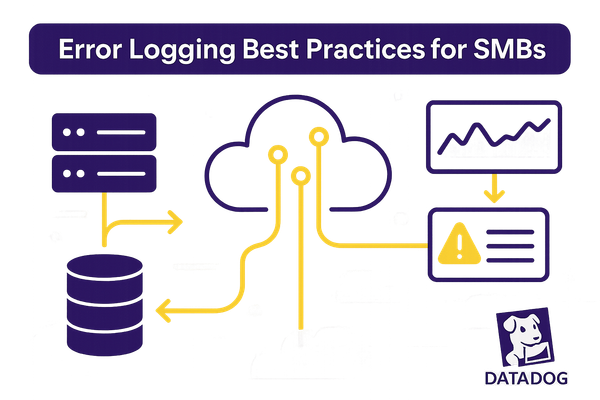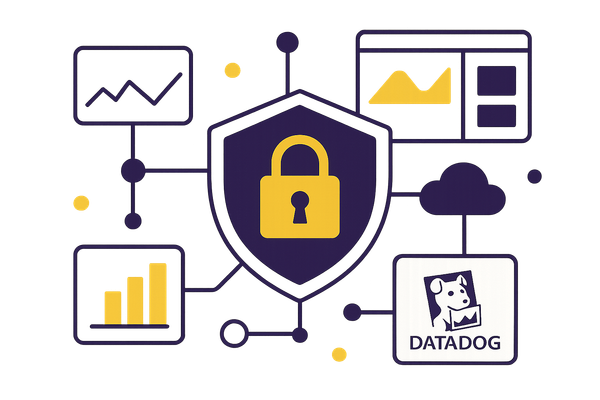Terraform Datadog Provider Changelog Overview
Explore how the latest updates to the Terraform Datadog Provider enhance monitoring efficiency and cost management for small and medium-sized businesses.

Manage your cloud monitoring smarter and save costs. The Terraform Datadog Provider now offers full API parity, cost management tools, advanced automation, and improved testing features. These updates simplify monitoring setups, automate workflows, and control expenses for small and medium-sized businesses (SMBs).
Key Highlights:
- Cost Controls: Automate spending alerts and manage budgets directly in Terraform.
- New Features: Enhanced synthetic testing (JavaScript, mobile, gRPC support), scoped application keys, and observability pipelines.
- Bug Fixes: Improved TLS handling, Azure integration commands, and role management.
- Automation: Define workflows as code and detect infrastructure drift seamlessly.
- Setup Tips: Use CI/CD pipelines and version control for efficient deployment.
These updates ensure SMBs can scale monitoring effortlessly while reducing IT overhead and maintaining system reliability.
How to Manage Datadog Resources Using Terraform | Datadog Tips & Tricks
What is the Terraform Datadog Provider
The Terraform Datadog Provider acts as a bridge between managing infrastructure and monitoring it effectively. It allows you to use Terraform to define and manage Datadog resources like monitors, dashboards, and alerts directly from your configuration files. This means when you deploy new servers, databases, or applications with Terraform, their monitoring setup is automatically created alongside them. This integration ensures that no important metrics are missed.
By connecting to the Datadog API, the provider provisions monitors, dashboards, and alerts based on your code. This approach simplifies the setup process while ensuring consistency, better visibility, and easier automation across your infrastructure.
Main Features and Functions
The Terraform Datadog Provider supports a variety of monitoring tools offered by Datadog, including:
- Metric Monitors: Keep an eye on CPU usage, memory consumption, or custom metrics from your applications.
- Log Monitors: Analyze application logs to detect error patterns or security threats.
- Synthetic Monitors: Test the performance of your websites and APIs from different geographical locations.
Dashboard creation is made easier with templating, enabling consistent visualizations across your services. You can also define alerting rules programmatically, setting escalation policies, notification channels, and specific conditions. Additionally, you can seamlessly connect Datadog with cloud providers, databases, and other services through Terraform, making the setup even more efficient.
These features create a secure and streamlined monitoring environment.
Setup Requirements for SMBs
Getting started with the provider is straightforward. First, obtain your Datadog API and application keys, and store them securely using either environment variables or a secrets manager.
Next, include the Datadog provider in your Terraform configuration and run terraform init to install it. You can specify the desired version of the provider in your configuration files. To ensure an organized setup, plan your monitoring structure ahead of time - establish naming conventions for monitors, arrange dashboards logically, and define clear escalation paths for alerts.
For small and medium-sized businesses (SMBs), integrating Terraform configurations with a CI/CD pipeline (using tools like GitHub Actions, GitLab CI, or Jenkins) is especially useful. This ensures that monitoring updates are reviewed, tracked, and deployed automatically. Using version control for your Terraform code also makes collaboration easier, helps you track changes over time, and allows for quick rollbacks if needed.
Recent Changelog Updates
The Terraform Datadog Provider has been actively updated, introducing new features and addressing stability issues. These changes enhance how small and medium-sized businesses (SMBs) manage their monitoring infrastructure, making it more efficient and adaptable.
New Features
Several notable features have been added to the provider:
- Cost management capabilities are now accessible through Terraform, helping SMBs keep better control over monitoring expenses.
- Scoped application key management for service accounts introduces granular access controls, minimizing security risks by restricting access to only essential resources without requiring complex manual setups.
- Synthetic testing enhancements include JavaScript assertions, mobile testing support, and gRPC testing capabilities, providing better monitoring for microservices and modern application architectures.
- Observability Pipelines now offer additional components, giving users more options to process and route monitoring data according to their operational needs.
- Default tag support simplifies security monitoring by ensuring consistent tagging across rules and service level objectives, improving security configurations for SMBs.
- In February 2025, Datadog launched Action Connection API support, allowing users to manage external service connections directly through Terraform.
In April 2025, Datadog introduced Workflows to Terraform, enabling "GlobalTech Solutions", a multinational IT services provider, to automate complex operational tasks. By defining workflows as code, GlobalTech reduced the time required to deploy new monitoring configurations across their global infrastructure by 30%, boosting reliability and lowering operational overhead.
Bug Fixes
Key bug fixes have been implemented to enhance the provider's reliability:
- TLS version handling in synthetic tests was corrected in version 3.66.0, ensuring accurate TLS protocol support.
- The datadog_monitors datasource was updated in version 3.63.0 to handle cases where no monitors match the specified criteria.
- Spans metric validation issues were resolved in version 3.61.0, preventing unintended side effects in monitoring configurations.
- Azure integration import commands were fixed in version 3.59.0, simplifying the process of managing Azure monitoring configurations with Terraform.
- Service account role management was improved in version 3.54.0 to ensure proper updates to role assignments when changes occur.
Improvements
Several enhancements have been introduced to improve functionality and ease of use:
- Logs archive encryption handling now supports a broader range of encryption configurations, improving compliance and storage efficiency.
- Additional metadata support for logs pipelines allows for more flexibility in organizing and processing log data, providing SMBs with better tools for troubleshooting and analysis.
- The ability to delete log indexes through Terraform enables better lifecycle management of log data, helping organizations control storage costs and maintain cleaner data organization.
- Error message updates for synthetics private locations, introduced in version 3.60.0, make troubleshooting easier by providing clearer guidance when issues arise.
- Protocol buffer file encoding in synthetic tests was refined in version 3.59.1, resolving file handling issues that could cause test failures.
These updates collectively improve the provider’s functionality, giving SMBs more control and efficiency in their monitoring processes while keeping costs in check.
How Updates Affect SMB Operations
The latest updates to the Terraform Datadog Provider bring practical improvements that can streamline operations for small and medium-sized businesses (SMBs). These updates reshape how SMBs manage their monitoring systems, making processes smoother and reducing the strain on limited IT resources.
Improved Automation and Monitoring
The new automation features significantly enhance how SMBs handle their monitoring workflows. For instance, the introduction of cost alert monitors allows businesses to set up automated spending alerts. Teams are notified when monitoring costs reach specific thresholds, helping to avoid unexpected budget spikes without requiring manual oversight.
Synthetic testing has also been upgraded, enabling development teams to define more detailed test scenarios as code. This ensures that crucial user journeys function properly, providing greater confidence in application performance.
Another key feature is improved infrastructure drift detection. This helps SMBs pinpoint when their current monitoring setup deviates from the intended configuration, ensuring consistency across environments and minimizing potential monitoring gaps.
Real-World Benefits for SMBs
These updates offer practical solutions for everyday challenges. For example, cost alert monitors can track spending by business unit or project, sending timely alerts when expenses exceed set limits.
Simplified log pipeline tagging makes it easier to manage compliance and troubleshoot issues by automatically applying uniform tags to security monitoring rules and service level objectives. This consistency aids in tracking performance metrics and spotting trends during incident investigations.
For SMBs using Azure, the updates are especially beneficial. Metric alerts can now monitor web app CPU usage, triggering notifications when usage exceeds 80%, or track storage capacity, alerting teams when available space drops below a defined threshold. Kubernetes users running AKS clusters can also benefit from automated scaling actions when CPU usage surpasses 80%. Additionally, integration with CI/CD pipelines allows monitoring configurations to be managed as code, ensuring changes are tracked, reviewed, and deployed consistently across environments.
These enhancements help SMBs maintain a dependable monitoring infrastructure while reducing the workload on technical teams, freeing them up to focus on tasks that drive business growth.
How to Update Provider Versions Safely
Updating the Terraform Datadog Provider requires a careful, step-by-step approach to avoid disruptions. For small and medium-sized businesses, this method helps reduce risks while allowing access to new features, bug fixes, and security updates. A structured process ensures system stability and smooth integration of improvements.
Safe Update Methods
The key to a safe update is isolating and testing changes before deploying them to production. Start by creating a dedicated Git branch for the provider upgrade. This separation makes it easier to spot issues and roll back changes if necessary.
Before making any changes, run a final terraform plan to address existing deprecation warnings. This step ensures you can differentiate between pre-existing issues and any new ones caused by the update.
When updating, focus first on modifying the provider version configuration. Run terraform plan to confirm that the output shows only import operations or no changes at all. Continue to verify updates incrementally by running plans frequently. Only proceed with terraform apply once you’ve confirmed there are no errors, warnings, or unexpected results.
Automation tools like GitHub Dependabot or Renovate can simplify the monitoring of provider updates. These tools can automatically generate pull requests for new releases. Additionally, subscribing to release notifications on the provider's GitHub repository keeps you informed about updates.
For example, HashiCorp’s upgrade of the AWS provider from v3.74.3 to v3.75.0 highlighted deprecated configuration blocks in S3 bucket resources. The solution involved removing the outdated
versioningargument and adding a separateaws_s3_bucket_versioningresource to maintain functionality.
Once the update is complete, shift your focus to validating the changes in a staging environment.
Using New Features
Testing new features in a staging environment that mirrors production is essential. This allows you to validate functionality without putting live systems at risk.
Carefully review the changelog and test each new feature in staging. Monitor this environment closely to identify any performance issues or unexpected behavior.
Document all changes and maintain open communication with your team throughout the process. Ensure everyone understands the upgrade timeline and any workflow adjustments. Use your project management system to track configuration changes for better clarity and accountability.
You can also integrate Terraform with CI/CD pipelines to automate testing and deployment. This reduces manual errors and ensures consistent updates across environments. Once confident in the new features, schedule the production deployment during a maintenance window. Apply changes incrementally, testing each component to confirm everything works as expected.
Staying on top of provider updates is about more than new features - it’s also about ensuring your monitoring infrastructure remains secure and reliable with the latest patches and fixes.
Conclusion
Keeping your Terraform Datadog Provider up-to-date is a smart move for small and medium-sized businesses aiming to improve monitoring and streamline operations. Regular updates unlock the full potential of Infrastructure as Code, offering benefits like version control, better observability, automation, and consistent infrastructure management.
By staying current, you also ensure your monitoring system remains secure and dependable. Updates address vulnerabilities, fix bugs, and enhance drift detection, helping you catch and resolve configuration mismatches before they lead to bigger problems. Plus, maintaining compatibility with the latest Datadog API features means you can take advantage of new tools and capabilities to boost your monitoring and management efforts.
When Terraform is integrated into CI/CD pipelines, deploying Datadog resources becomes more efficient and less error-prone. This automation frees up your team to focus on higher-level projects instead of repetitive manual tasks.
Make it a habit to review Datadog and Terraform documentation regularly to stay informed and ensure your setup remains secure and effective. Consistent updates not only provide access to new features but also help maintain a reliable monitoring framework that supports your business as it grows.
For more tips on getting the most out of your Datadog implementation, check out Scaling with Datadog for SMBs. You'll find tailored advice and expert resources designed specifically for small and medium-sized businesses.
FAQs
How can the Terraform Datadog Provider help SMBs optimize monitoring costs?
The Terraform Datadog Provider simplifies monitoring for small and medium-sized businesses (SMBs) by automating the management of Datadog resources such as dashboards and monitors. By automating these processes, businesses can ensure better use of resources and avoid over-provisioning, which often leads to unnecessary expenses.
Although a specific Cloud Cost Management resource hasn't been introduced yet, active development is underway to add features that will help SMBs optimize costs even further. This makes the provider a practical choice for businesses aiming to improve efficiency while keeping monitoring expenses under control.
What are the advantages of using Terraform with CI/CD pipelines for monitoring setups?
Integrating Terraform into your CI/CD pipelines can transform how you handle monitoring configurations. By automating infrastructure updates, you reduce the chances of manual errors, maintain consistency, and speed up deployment processes.
This setup also makes it easier to adjust and expand your monitoring environments as needed. With continuous updates in place, your systems stay reliable and current without the hassle of manual changes, ensuring smoother management and better efficiency overall.
What steps can SMBs take to safely upgrade to the latest version of the Terraform Datadog Provider?
To upgrade to the latest version of the Terraform Datadog Provider without issues, small and medium-sized businesses (SMBs) should consider these steps:
- Leverage version control: This helps track changes and makes it easier to revert to previous versions if something goes wrong.
- Keep providers updated: Regular updates ensure compatibility with new features and bug fixes.
- Run
terraform init -upgrade: This command ensures the provider is updated correctly. - Check release notes and changelogs: Reviewing these can help you spot any breaking changes or deprecated features before upgrading.
Following these practices can help SMBs maintain stability and avoid unnecessary disruptions when upgrading their infrastructure.




